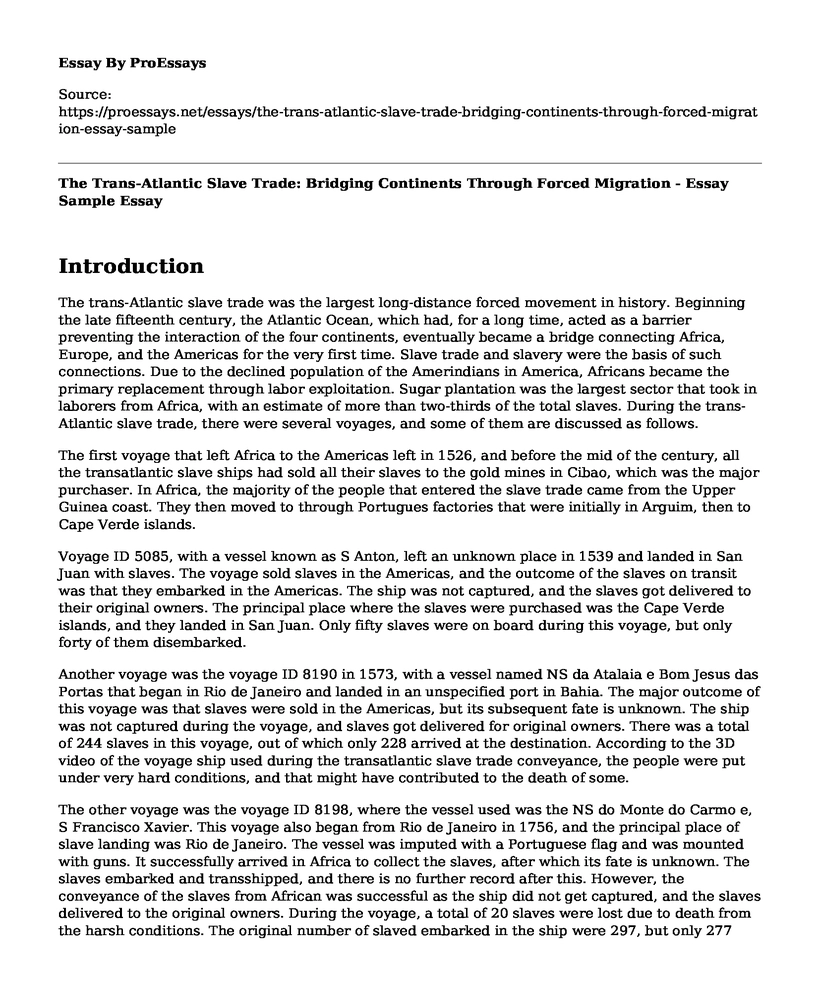Introduction
The trans-Atlantic slave trade was the largest long-distance forced movement in history. Beginning the late fifteenth century, the Atlantic Ocean, which had, for a long time, acted as a barrier preventing the interaction of the four continents, eventually became a bridge connecting Africa, Europe, and the Americas for the very first time. Slave trade and slavery were the basis of such connections. Due to the declined population of the Amerindians in America, Africans became the primary replacement through labor exploitation. Sugar plantation was the largest sector that took in laborers from Africa, with an estimate of more than two-thirds of the total slaves. During the trans-Atlantic slave trade, there were several voyages, and some of them are discussed as follows.
The first voyage that left Africa to the Americas left in 1526, and before the mid of the century, all the transatlantic slave ships had sold all their slaves to the gold mines in Cibao, which was the major purchaser. In Africa, the majority of the people that entered the slave trade came from the Upper Guinea coast. They then moved to through Portugues factories that were initially in Arguim, then to Cape Verde islands.
Voyage ID 5085, with a vessel known as S Anton, left an unknown place in 1539 and landed in San Juan with slaves. The voyage sold slaves in the Americas, and the outcome of the slaves on transit was that they embarked in the Americas. The ship was not captured, and the slaves got delivered to their original owners. The principal place where the slaves were purchased was the Cape Verde islands, and they landed in San Juan. Only fifty slaves were on board during this voyage, but only forty of them disembarked.
Another voyage was the voyage ID 8190 in 1573, with a vessel named NS da Atalaia e Bom Jesus das Portas that began in Rio de Janeiro and landed in an unspecified port in Bahia. The major outcome of this voyage was that slaves were sold in the Americas, but its subsequent fate is unknown. The ship was not captured during the voyage, and slaves got delivered for original owners. There was a total of 244 slaves in this voyage, out of which only 228 arrived at the destination. According to the 3D video of the voyage ship used during the transatlantic slave trade conveyance, the people were put under very hard conditions, and that might have contributed to the death of some.
The other voyage was the voyage ID 8198, where the vessel used was the NS do Monte do Carmo e, S Francisco Xavier. This voyage also began from Rio de Janeiro in 1756, and the principal place of slave landing was Rio de Janeiro. The vessel was imputed with a Portuguese flag and was mounted with guns. It successfully arrived in Africa to collect the slaves, after which its fate is unknown. The slaves embarked and transshipped, and there is no further record after this. However, the conveyance of the slaves from African was successful as the ship did not get captured, and the slaves delivered to the original owners. During the voyage, a total of 20 slaves were lost due to death from the harsh conditions. The original number of slaved embarked in the ship were 297, but only 277 reached Rio de Janeiro.
The other voyage was the voyage ID 8488, which embarked in 1738 from an unspecified port in Southeast Brazil and landed the slaves in Rio de Janeiro. The vessel had Portuguese and Brazilian flags. At least one slave was bought in Africa, but the subsequent fate unknown. The ship was not captured, and the slaves embarked and transshipped successfully, though the original goal of this voyage got thwarted due to a natural hazard.
The transatlantic slave trade was one of the largest coercive trade in the world, and it lasted for a very long time from the mid of the 15th century to the end of the 19th century. During this period, there were several voyages that transported slaves from Africa to Europe and America, all of which got dispensed at different times and for different destinations. The first voyage ship sailed from Africa to the Americas in 1526. There was also the slave traffic with any voyages to Brazil in 1560, which transported Africans to America to replace the Amerindians who were declining in population and who were the major laborers at that time. From examining these manifests, one thing I can learn is that the transatlantic slave trade was a determining factor in the world economy. Besides, the examination of these voyages also revealed the extent to which the Europeans planned before executing any voyage, and this led to the high success rates of the slave trades. One way in which this is evident is from the structure of the voyage ship that had all the required sections to ensure that the slaved remained in custody throughout the transit.
Bibliography
Slavre Voyages. "Trans-Atlantic Slave Trade - Estimates." Retrieved from https://slavevoyages.org/assessment/estimates
Solow, Barbara L. "The transatlantic slave trade: A new census." The William and Mary Quarterly 58, no. 1 (2001): 9-16. Retrieved from https://www.jstor.org/stable/2674416
Cite this page
The Trans-Atlantic Slave Trade: Bridging Continents Through Forced Migration - Essay Sample. (2023, May 15). Retrieved from https://proessays.net/essays/the-trans-atlantic-slave-trade-bridging-continents-through-forced-migration-essay-sample
If you are the original author of this essay and no longer wish to have it published on the ProEssays website, please click below to request its removal:
- The Childhood War Trauma Analysis
- The Road From Slavery to Success Essay
- Essay Sample on Impact of Slavery on Development of Unites States Economy
- Essay Sample on 1960s US: Revolution, War, and Social Change
- Essay Example on African Migration: From Slavery to Freedom in America
- Secession: Causes of the 1860s U.S. Civil War - Essay Sample
- Paper Sample: Tacitus Account of the Ancient German People







